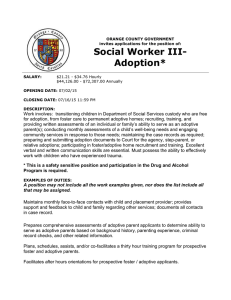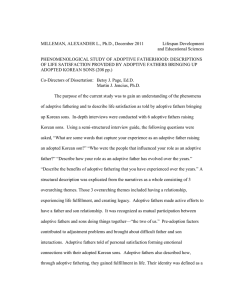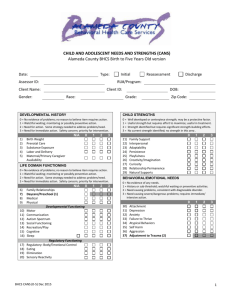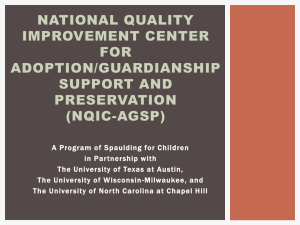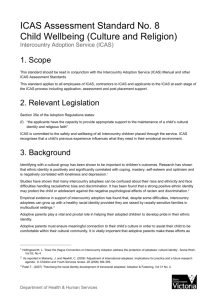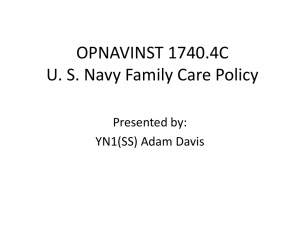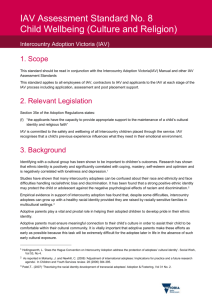Document 5852572
advertisement
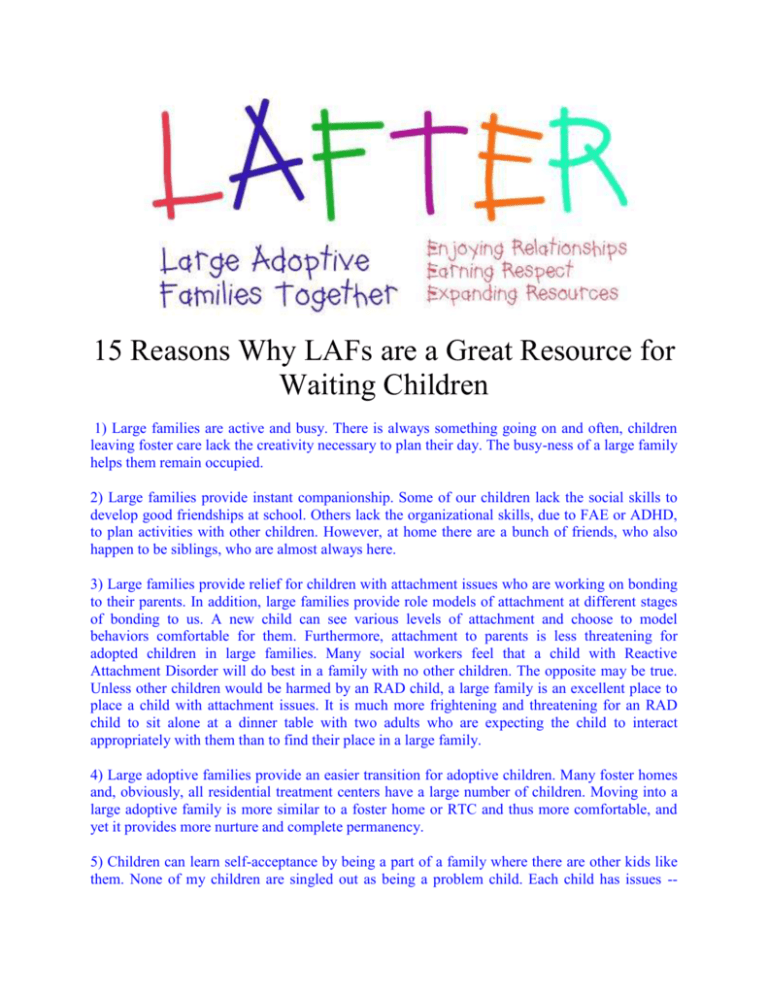
15 Reasons Why LAFs are a Great Resource for Waiting Children 1) Large families are active and busy. There is always something going on and often, children leaving foster care lack the creativity necessary to plan their day. The busy-ness of a large family helps them remain occupied. 2) Large families provide instant companionship. Some of our children lack the social skills to develop good friendships at school. Others lack the organizational skills, due to FAE or ADHD, to plan activities with other children. However, at home there are a bunch of friends, who also happen to be siblings, who are almost always here. 3) Large families provide relief for children with attachment issues who are working on bonding to their parents. In addition, large families provide role models of attachment at different stages of bonding to us. A new child can see various levels of attachment and choose to model behaviors comfortable for them. Furthermore, attachment to parents is less threatening for adopted children in large families. Many social workers feel that a child with Reactive Attachment Disorder will do best in a family with no other children. The opposite may be true. Unless other children would be harmed by an RAD child, a large family is an excellent place to place a child with attachment issues. It is much more frightening and threatening for an RAD child to sit alone at a dinner table with two adults who are expecting the child to interact appropriately with them than to find their place in a large family. 4) Large adoptive families provide an easier transition for adoptive children. Many foster homes and, obviously, all residential treatment centers have a large number of children. Moving into a large adoptive family is more similar to a foster home or RTC and thus more comfortable, and yet it provides more nurture and complete permanency. 5) Children can learn self-acceptance by being a part of a family where there are other kids like them. None of my children are singled out as being a problem child. Each child has issues -- often different from the others and yet sometimes the same. It's not weird in large adoptive families to take pills in the morning, to go to therapy, to have diagnosis, to have an IEP. 6) Adoptive parents of a large number of adopted children learn coping techniques that keep them psychologically healthier. Disengaging and self-differentiation are learned survival skills which allow adoptive parents to appropriately deal with even the worst behaviors. 7) Adoptive parents of a large number of adopted children are familiar with resources, issues, and support systems. We know how to advocate in IEP meetings, find therapists who are familiar with adoption and attachment issues, fill out hoards of paperwork, acquire respite services, etc. 8) Adoptive parents of large families have a better idea of what types of children they can handle. They know which types of children and which issues they can handle. They can wade through descriptions and psych evals and know if a child would do OK in their home or not. 9) Disruptions are less likely to occur in large adoptive families. While I have no statistics to back me up, I'm fairly certain that families who have adopted and stuck with many different kinds of kids would be less likely to disrupt for less than life-threatening reasons. Often children who have been placed into a large adoptive family after a disruption do much better in that setting. 10) Expectations for children in large adoptive families remain reasonable. Unrealistic expectations can destroy children. Parenting several children with emotional issues and a myriad of diagnosis helps parents to maintain realistic expectations. 11) In order to survive, large families must have structure and consistency. Often older children being adopted must have this kind of environment to function. 12) Almost all large adoptive families have at least one, sometimes two, stay at home parents. This constancy is so important for special needs kid and to know that mom or dad is always home is comforting for them. They need to know what to expect. This also assures that the children have one-on-one time with parents. 13) Large adoptive families teach cooperation, life skills, and responsibility. It is physically impossible for parents of large families, without outside help, to maintain a household, including cooking, cleaning, and laundry, when there are several children. For this reason, children must work together to assist parents in keeping the house running smoothly. 14) Large sibling groups can better melt into a large family. A sibling group of three placed into a family who only has two children, for example, creates an odd situation because the newcomers outnumber the existing children. This can be a very weird dynamic. 15) Many large adoptive families are headed by parents who have made raising children their life's passion and purpose. There are few outside activities that don't involve children. Parents like this don't add children to their lives -- they make children their lives. Claudia Fletcher, September 2000

![IN SUPPORT OF [BILL/LOCAL LAW/ORDER #] TO PREVENT](http://s3.studylib.net/store/data/007674137_2-0977e9eebbd334a0536cbc5b9f940004-300x300.png)
